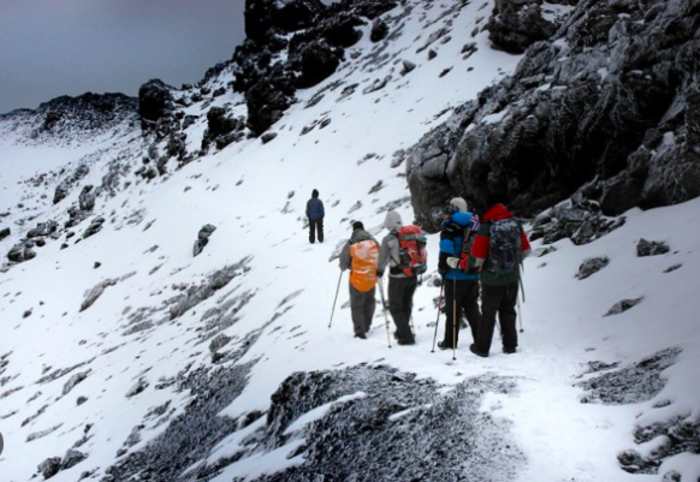CLIMATE WEATHER ON MOUNT KILIMANJARO
What is the weather on Kilimanjaro.
Tuesday, 31.Oct 2023
The weather on Mount Kilimanjaro can vary from very hot to extremely cold within the same day although it does not experience wide temperature changes from season to season.
At the base, the average temperature is around 21 to 27 centigrade and at the summit, uhuru peak, the night time temperature can range between 20 and -20 degrees Fahrenheit (-7 to -29 degrees Celsius). Like all great mountains, Kilimanjaro creates its own weather which can be extremely variable and difficult to predict. Hikers need to be
prepared for warm, sunny conditions, and rain, wind, cold, and even snow.
Standing at 19,341 ft above sea level, Kilimanjaro is big enough to create its own weather systems. Being on the equator means the trade winds (sometimes called ‘monsoons’) that move across the ocean, drawing moisture upward are interrupted by the mountain. This causes the wind to push up towards the summit, cooling as it goes, bringing rain and snow.
The long rainy season between March and May is a result on the trade winds from the south-east. These southerly winds from the Indian ocean are laden with moisture, bringing rain to the lower slopes and snow on the Mount Kilimanjaro summit. During this season, the southern slopes get the most rainfall.
The “short rains’ in November are from a dryer wind coming from the Northeast, as it hasn’t traveled across an ocean, the rains are shorter and intense than during the long rains. Most of the rainfall during this season falls on the more northerly slopes.
Kilimanjaro Temperature
At the summit of Kilimanjaro, Uhuru Peak, which lies in the arctic zone the night temperatures can range between 20 and -20 degrees Fahrenheit (-7 to -29 degrees Celsius0. Therefore, we recommend that you should always be prepared for wet and cold nights so please bring the necessary gear at all times.
Kilimanjaro Weather: What to Expect
Because Mount Kilimanjaro is such a large geographic structure it essentially creates its own weather.
In this article, we have provided an overview of the types of weather you can expect on Kilimanjaro, as well outlined historical weather patterns for each of Kilimanjaro’s climatic zones.
Trade and Anti-Trade Wind
Why?
Because winds carry moisture from the ocean. When they hit large objects, like mountains, they rise, cool and condense, forming clouds and precipitation (i. e rain and snow)
There are two main winds that drive weather patterns on Mount Kilimanjaro – the south east trade winds are northeast ant-trade winds we explain the influence of each wind below.
South – East Trade Winds
The south East trade winds from then Indian ocean arrive around mid-march and last well into may (before being interrupted by the North – east anti trade winds).
This wind carry loads of moisture from the Indian ocean so when they eventually hit the massive structure of Mount Kilimanjaro and are forced upwards, they form large rain clouds and the heavens open.
Mid-march through to the end of May is therefore the wet season on Mount Kilimanjaro and not a great time for trekking
That being said, as these winds blow from the south most of the rain falls on the southern side of Kilimanjaro.
If one wants to trek in March-May it is best to consider the Rongai Route which follows a trail from the North
North-East Anti-trade Winds
They generally blow quite strongly forcing their way through the saddle (the valley between Kilimanjaro’s two peaks – Kibo and Mawenzi)
As the strong anti-trade winds pass through the saddle they force the South-East wind down below them. Hence during the dry season (June through to October) cloud cover and some rain is common up to the 3,000 but quickly disappears above this altitude.
The dynamic between the strong and dry North-East trade winds and the less powerful South-east winds winds means that late May through to the end of October is a great time to trek as rain is rare and usually confined to the lower southern slopes.
May through to October also coincides with the summer holiday periods of the Northern Hemisphere so the slope of Kilimanjaro can be busy at this time of the year.
North-East Monson
Most of this rain falls on the lower northern slopes of Mount Kilimanjaro but is a lot lighter than the main wet season brought but the South-east winds in March-May
The interaction of these winds with Mount Kilimanjaro Means that there are two main trekking Season January-March and June-October.
Best time to trek Kilimanjaro
January to March
January through to march is the first dry season on Kilimanjaro, making it a great time to trek. This time of the year tends to be colder than the June-October trekking season and you have a much higher chance of encountering snow on the upper reaches.
April and May
April and May are usually the wettest months and not ideal for ideal for trekking
This is the busiest trekking season as it coincides with the European and American summer holiday period. Encountering rain or snow is rare. As the slopes are busier at this time of the year it is quite easy to find tour companies that offer open groups that you can join to help save costs.
November to December
On November is a short rainy month. If you plan to trek this month we recommend the northern approach on the Rongai, which is generally dry. December is a cold month, usually with lots of snow, trekking is fine if you don’t mind the cold.
Snow on Kilimanjaro can occur all year round, but the most common months are November through March. Here is a chart showing average snowfall by month.







